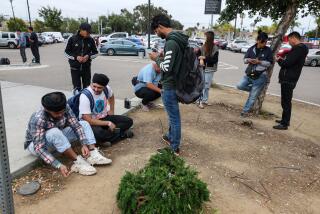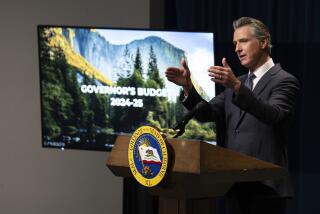Hitting the Pavement, Fingers First
- Share via
If your boss shows you the door, it’s probably your fingers that will do the walking.
California is phasing in a phone-in plan for those seeking unemployment benefits. The goal is for regional processing centers to handle 90% of all claims over the telephone by 2000.
The plan should make applying for unemployment benefits far easier for laid-off workers: no more humiliating long lines, just a 10-minute call from home.
It’s also intended to make unemployment officials more efficient by separating the twin tasks of processing claims and helping workers find new jobs.
In some areas, like San Diego and Ventura counties, laid-off workers are already filing claims by phone. Orange County’s four unemployment offices finished switching over April 22. Calls are being handled at a regional office with a staff of 122.
The process of converting to phone service is underway in Los Angeles, San Bernardino and Riverside counties.
Satisfaction surveys show that 90% of claims filers are enthusiastic about using phones, said Suzanne Schroeder, a spokeswoman for the state Employment Development Department.
Some, particularly older workers under stress from losing a job, still want to look a human being in the eye. And those who walk into a state employment office won’t exactly be turned away cold.
“But we do not have the capacity to file the claim here,” said Janet S. Strand, manager of the Mission Viejo office, the last of the Orange County offices to switch.
“We would actually stand beside them and help them as they file a claim over the phone,” Strand said.
Don D. Sessions, an employment lawyer whose office adjoins the state agency’s Mission Viejo facility, said he thinks there should be both phone and walk-in service.
Under the old system, it was easier for people to pick up literature about job hunting and to see for themselves what services were available, he said.
“They should state in their literature and right on their phone line what is available for people if they choose to come into the office,” Sessions said. “Then you would have the best of both worlds.”
State officials say they are trying to be flexible. When Compton leaders expressed fears that the unemployment office would close, the agency promised to keep it open--and to allow claims to be filed in person, Schroeder said.
But she said some offices will close, or at least downsize, as they quit processing claims and become job-search centers where the unemployed can browse on computers for openings.
Eventually, there will be more, but smaller, state employment facilities, set up at or near welfare, job-training and college placement offices and perhaps even in kiosks at malls, Schroeder said.
The state introduced the phone program in December 1995, in rural areas of Northern California where some applicants faced long drives through the snow.
In calling for benefits, applicants answer a series of automated questions and give their Social Security number, employment history and other information to a real person. Applications can also be taken in Spanish, Vietnamese and Mandarin.
Officials played down the potential for fraud. Walk-in applicants for unemployment have never been required to prove their identities, and officials said computerized cross-checks of wage and other data work just as well for telephone claims.
More to Read
Inside the business of entertainment
The Wide Shot brings you news, analysis and insights on everything from streaming wars to production — and what it all means for the future.
You may occasionally receive promotional content from the Los Angeles Times.










